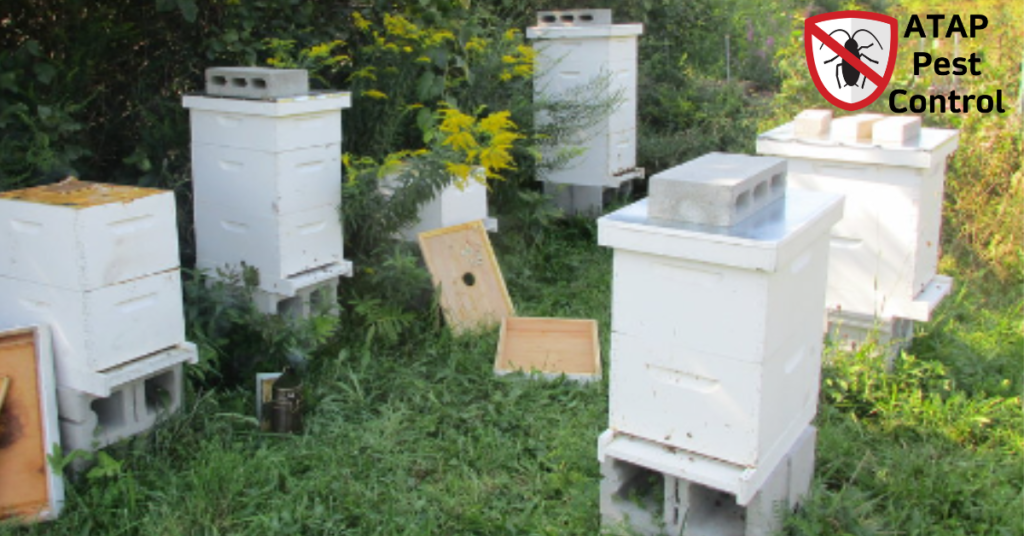Bees and their hives are essential components of our environment. They play an important role in the pollination of crops, which is why it’s so important to find ways to keep them safe and healthy. One way to do this is by placing beehives on cinder blocks. Cinder blocks provide a sturdy structure for the beehive, as well as protection from weather and predators. Why there’re beehive on cider blocks?

In this article, we’ll explore the benefits of using cinder blocks for bee hives and discuss some tips for setting up your hive.
Advantages Of Using Cinder Blocks
Cinder blocks provide an easy and cost-effective way to build a beehive. They are durable, lightweight, and weatherproof, making them the perfect material for construction projects. Not only that, but cinder blocks offer a strong foundation for the beehive, meaning they will last through all seasons and withstand any kind of weather.
Furthermore, cinder blocks also provide a simple yet secure way to stack multiple levels of hives, which is essential in beekeeping. If you are looking for Chicago bee removal, then contact ATAP anytime.
Safety is paramount when building a beehive. Cinder blocks provide stability and security while also keeping the hive sheltered from potential predators. The thick walls make it difficult for animals to get inside and disturb the bees or their honeycombs. Also, since cinder blocks are so strong and durable, they can support even the heaviest of hives without the worry of collapse or damage.
Building a beehive with cinder blocks is relatively easy and requires very few tools or materials. All one needs to do is place the cinder blocks securely on level ground, then start stacking them until the desired size and shape of the hive is achieved. With minimal effort and cost one can create a safe haven for their bees that will last for years to come.
Building A Secure Foundation
Cinder blocks are a great choice when you need to build a secure foundation. They’re strong and sturdy, and they can support large structures. In addition, they’re relatively easy to install and require minimal tools.
Now that you’ve decided on your cinder blocks, it’s time to get started with the installation process. The first step of the process is to prepare the area for installation. Make sure the surface you’ll be working on is level and clear of debris. To ensure the stability of your structure, it’s best to dig a few inches into the ground and fill it in with gravel or sand before placing the cinder blocks. Doing this will make sure that your foundation won’t shift over time due to natural movement or weather-related changes in soil composition or temperature.
Once you’re ready to start laying down your cinder blocks, use a tape measure to ensure proper spacing between them as you work. Then fill any gaps between them with mortar mix so that everything is held firmly together. If done correctly, this will provide an extremely secure base for whatever structure you’re building, be it a beehive or something else entirely!
After all of your cinder blocks are laid down and secured with mortar mix, your foundation is complete – now it’s time to focus on placing the rest of your structure’s components securely on top of them.
Placing The Cinder Blocks
The foundation of a beehive is an important part of its longevity. This is why it’s essential to ensure that the cinder blocks used to build the base are properly placed.
To begin, make sure you have the right number and types of cinder blocks for your hive.
Once you have the necessary materials, here’s what you need to do:
Prepare the Area
- Level out the ground with a shovel or rake.
- Place sand or gravel in the area if desired. This will help create a stable foundation.
Place the Cinder Blocks
- Begin by placing one cinder block at each corner of where you want the beehive to go. Stack additional blocks on top until you reach your desired height. Make sure to leave room for other components like frames, wax sheets, and ventilation ports.
- Once all of your cinder blocks are in place, use a leveler to check that everything is even and straight. Make any adjustments as necessary before moving on to securing the hive to the blocks.
Placing cinder blocks correctly is absolutely essential for creating a safe and secure beehive foundation. By following these steps, you can get it done quickly and easily—setting yourself up for success when it comes time to install your beehive components!
Securing The Hive To The Blocks
Having placed the cinder blocks, the next step was to securely fasten the beehive to them. We had to ensure that it wouldn’t move and hinder the bee’s activity. It was a daunting task, but with a bit of ingenuity and some old-fashioned elbow grease we were able to construct a secure foundation for our hive.
We used scrap lumber, screws, and nails to build a frame around the base of each block. This created a solid platform that we could then attach the hive directly onto. We pre-drilled holes into both the wood frame and the beehive so that we could use screws to firmly secure everything together.
With the hive now sturdy and immovable, our attention shifted toward other considerations, such as ventilation and insulation. To ensure temperature stability within our hive, we had to take all these factors into account before moving on with our project.
Other Considerations
When deciding to use cinder blocks for your beehive, there are some important considerations.
The environment of the hive should be taken into account; cinder blocks may not provide adequate insulation from extreme temperatures or other elements.
Additionally, the weight of the hive must be considered when placing it on the blocks. You will need to make sure that the blocks are strong enough to support the weight of your hive as well as any additional equipment you may have inside.
While cinder blocks can provide a stable foundation for your beehive, they can also become a safety hazard if not secured properly. It is important to make sure that all cinder blocks are firmly in place and will not move when bees enter and exit the hive. If they do shift during activity, it could cause injury or damage to both the bees and the hive itself.
Finally, it is also essential to ensure that proper ventilation is provided within your hive by setting up vents near areas where air flow can occur easily. Proper ventilation reduces humidity levels and keeps air moving throughout the hive, which helps prevent issues with mold or mildew buildup.
With these considerations in mind, you’ll be ready to move on to setting up your hive in an optimal way for your bees.
Tips For Setting Up Your Hive
Now that you’re familiar with the other considerations when setting up a beehive on cinder blocks let’s move on to tips for doing just that.
Firstly, it’s important to select a flat and level surface. This will ensure your hive remains level, providing stability for the bees and easy access for beekeepers.
Secondly, it’s essential to use cinder blocks that have been treated with an anti-termite solution. Termite infestations can quickly spread through wood and cause damage to both the hive and any surrounding structures.
When placing your cinder blocks, be sure to leave enough room between them for airflow and for easy removal if necessary. Additionally, using galvanized nails or screws is best as they are not vulnerable to rust or corrosion from being in contact with moisture or humidity.
Here’s a quick checklist of items you’ll need:
- Anti-termite-treated cinder blocks.
- Level surface
- Galvanized nails/screws
- Drill/Driver (optional)
Finally, make sure you regularly inspect your hive and the cinder blocks on which it sits. Make any necessary repairs to keep the structure safe and secure for the colony of bees living inside. Regularly monitoring your setup will help ensure your hive stays healthy throughout its lifespan.
Frequently Asked Questions
What Type Of Bees Should I Use For My Hive?
When it comes to which type of bees you should use for your hive, there are two main options: honeybees and bumblebees.
Honeybees are a popular choice because they tend to be more docile than other types of bees, making them easier to manage. They also produce honey and wax, which can be harvested for commercial sale.
Bumblebees, on the other hand, aren’t as docile but they do provide pollination services that can benefit nearby gardens and crops.
Ultimately, the decision depends on your individual needs and preferences.
How Often Should I Check The Hive For Pests Or Disease?
It’s important to regularly inspect your beehive, preferably every two weeks or so, for pests or diseases.
There are a few things to look out for, like varroa mites and wax moths, which can quickly spread and cause significant damage.
Additionally, check the frames and combs for signs of disease, such as mold or discoloration.
If you spot any of these issues early on, you’ll have a better chance of solving the problem before it becomes too serious.
Are Cinder Blocks The Only Type Of Foundation I Can Use For My Hive?
When it comes to setting up a beehive, there are several options for the foundation.
Cinder blocks can be used, but they’re not the only type available.
Other common foundation materials include wooden pallets, concrete blocks, and brick foundations.
Each of these options has its own unique benefits and drawbacks, so it’s important to weigh them before making your decision.
What Is The Best Way To Insulate My Hive Against Extreme Temperatures?
When it comes to insulating your beehive against extreme temperatures, there’s no ‘one-size-fits-all’ solution.
However, by taking a few key steps, you can ensure your hive is as well-protected as possible.
To start, try utilizing an array of materials to create a barrier between the inside and outside of the hive.
You could use straw bales, insulation boards, or even bubble wrap!
Additionally, consider adding extra ventilation to help regulate the temperature and keep your bees comfortable – whatever you choose to do, make sure it’s tailored to suit your particular environment.
Are There Any Additional Safety Precautions I Should Take When Working With My Hive?
When working with beehives, it’s important to take additional safety precautions.
First and foremost, always wear protective gear such as a beekeeper suit and gloves. Also, be sure to cover any exposed skin, such as your arms or face.
It’s also helpful to keep a smoker handy in case of defensive behavior from the bees.
Lastly, avoid disturbing the hive too often – don’t enter it more than once a week, and when you do make sure to move slowly and calmly.
Following these tips will help ensure your safety when working with your beehive.
Conclusion
The relationship between a beekeeper and their hive is like any other relationship: it requires dedication and patience. It takes time to get to know the bees, understand their needs, and build trust.
Just as cinder blocks provide a strong foundation for a beehive, the bond between keeper and hive must also be built on a solid foundation of knowledge, respect, and care. With this in mind, I’m confident that my hive will thrive for years to come.
Read what can be the beehive distance from house. The key is to remember that it’s not just about tending to the bees; it’s about creating an environment where they can flourish and be happy. By taking the time to understand and care for my little ‘family’ of bees, I’ll ensure that our hive remains strong and successful for years to come. Atap Exterminators bee hive removal Chicago is a well-known company in Chicago. 24/7 service is available throughout the town; contact them anytime at (708) 980-0092.
